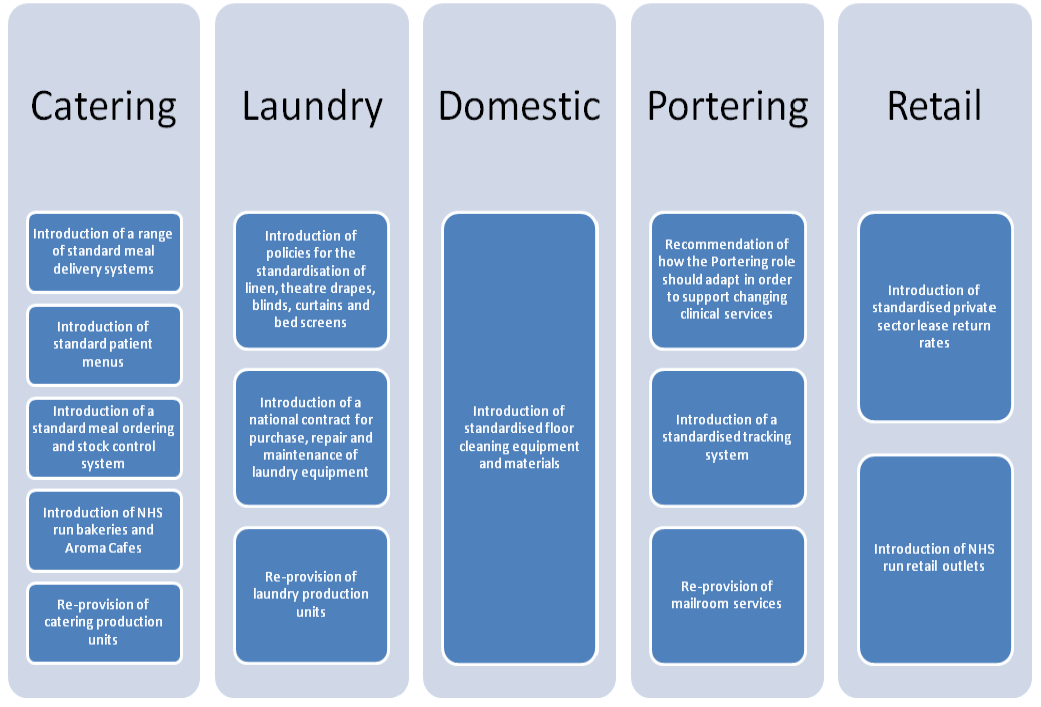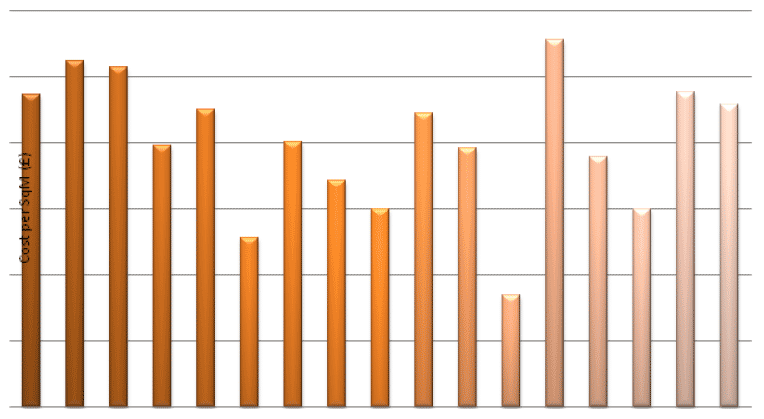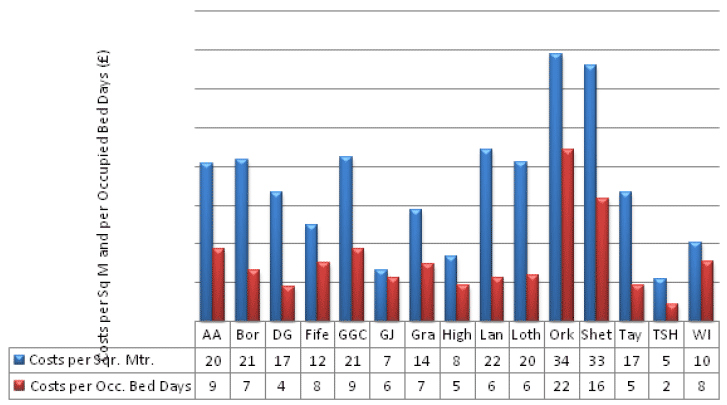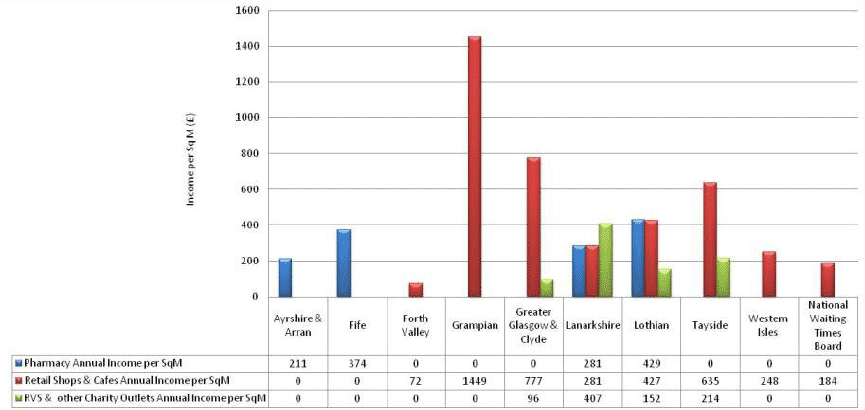Annual State of NHSScotland Assets and Facilities Report for 2014
Report on the State of the Estate 2014
Annex G
Strategic Review of Soft Facilities Management Services
1. Objectives
Review all Soft Facilities Management Services across NHSScotland to see how the current service works and look at a number of service improvement opportunities to improve efficiency, patient safety and user satisfaction.
The outcome of this work will be a review report which will be presented to NHS Chief Executives and the NHS Efficiency Portfolio Board to agree which opportunities should be taken forward.
2. Progress
In January 2013 a brainstorming event was held which gave NHS facilities staff from across NHSS the opportunity to take an active role in the strategic direction for Soft FM, challenge current thinking and suggest service improvements / efficiencies in all services covered by the review. From the event, over 150 proposals and ideas were generated which, along with suggestions contained within the original Project Initiation Document, has provided the foundation for this review.
NHS HFS Technical Advisory Groups and a subgroup of the Strategic Facilities Group considered and shortlisted the proposals and ideas generated from the event and considered whether the suggestion should be taken forward as part of the programme, not to be considered, not prioritised as this stage or should be referred back to the Technical Advisory Group to be progressed.
The key themes from these items were then assessed and service improvement opportunities developed (As shown in Chart 1 below). These were then were approved by the Assets and Facilities Management Programme Board in June 2013.
Chart 1 - Service Improvement Opportunities assessed as part of the Strategic Review of Soft FM Programme

Strategic Service Review Groups, with Partnership representatives, were formed in August 2013 which assessed the current service provision (baseline data) and the service improvement opportunities and made recommendations for project initiation.
The programme has utilised existing data sources wherever possible. For operational service data there is a range of potential sources. The Scottish Health Service Costs (known as the Costs Book) is the only source of published costs information for NHSS and provides a detailed analysis of where resources are spent in the NHSS. This information is mainly derived from financial and statistical data compiled by Scottish Health Boards. For Soft FM services, the Costs Book data has an element of proportioned costs for central services, such as HR, Payroll etc, which are not directly under the control of Soft FM management and budgets and vary across NHS Boards. Utilising this data source would not be able to provide an accurate reflection on the operational features and costs of Soft FM services across NHSS.
HFS operates the Facilities Management System (FMS) which is used to support benchmarking in a selection of Soft FM services across NHSS. As NHS Boards' usage with the FMS matures, data completeness, accuracy and reliability will improve. The FMS Benchmarking system predominately reviews services across NHSScotland, however some service information is limited to larger acute sites and does not include Soft FM service delivered at smaller location or collect any retail data. Utilising only this data source would have limited the scope of this review and would not be able to accurately reflect current service provision across the entirety of Soft FM services.
Baseline service data gathered for Catering, Domestic, Linen & Laundry, Portering and Retail services, as guided by the Strategic Service Review Groups, covers the financial year of 2012/13 and more recent where relevant.
Catering Reviews and the Catering Information System
Also completed as part of the Soft FM programme in 2013/14, was an independent review of patient and non-patient catering services across all NHS Boards. These individual reviews provided each NHS Board with an accurate and Board-specific appraisal of:
- Catering operations in each NHS site
- Accurate costs for provision of patient meals
- Non-patient trading account balance
- Opportunities to improve quality, reduce cost and increase income in the short and medium term.
These catering reviews have been completed by a catering expert, who has worked within the NHS environment in a number of locations. Catering reviews for all NHS Boards were completed by May 2014. Although there is significant variation in the costs of patient meals, food and labour across NHSScotland, the initial findings have also shown a high standard in the quality of food and service.
Following on from the Catering Reviews it was clear that catering teams needed the support of a bespoke information tool. The Catering Information System has a number of features including:
- stockPlan - Stock take and tracking module bespoke to the location and supports electronic data capture
- prodPlan - production planning and tracking that allows full interrogation and analysis of all aspects of the catering department including menu costings and wastage tracking
- manReport - Management reporting suite allowing full analysis and trending
- salesPlan - full retail sales analysis with innovative price tracking and setting
The rollout of the Catering Information System across NHSScotland continues. The system was originally piloted in Borders and Fife. The system has now been introduced in NHS Orkney, Shetland and Tayside.
The Catering Information System is also being used within Monklands Hospital (NHS Lanarkshire) and this includes the trial of menuPick - an electronic bedside meal ordering system for patients. The Hotel Services team member enters patients' meal choices into a handheld tablet which transmits the orders to the catering department for planning, preparation and delivery.
The menuPick system is being implemented in 11 wards resulting in a better quality food offering, timely delivery and significant reductions in food wastage across these wards. The new system has also helped to simplify the meal ordering process, benefiting patients and releasing nursing staff time for more care related duties.
3. Soft FM 2012/13 Productivity Findings
As the service models in operation across NHSScotland vary, so does productivity. Soft FM productivity measures, such as the cost of inputs to provide defined outputs, indicate a significant range across all services.
There is a degree of natural variation influenced by a number of factors including geography, existing service arrangements, Board functions, existing equipment or buildings, shift patterns, PFI arrangements or management structures. For example, The Island Boards (NHS Orkney, Shetland and Western Isles) receive the Scottish Distant Islands Allowance (SDIA), paid to all public service employees, which therefore reflects in the higher labour costs relative to mainland NHS Boards. A High Security Environment Allowance is also paid to The State Hospital employees.
However the productivity baselines also indicate potential for reducing efficiency variation in Board practices through improved standard and target setting as well as realising prioritised service improvement opportunities.
Catering
The total food and labour cost per patient per day varies across the different service types. Chart 2 demonstrates that Bulk and Plated Hotline services cost on average £16, Cook Freeze and Delivered Meals between £11.46 and £11.65 and the Cook Chill service £7.57. It should be noted that the Cook Chill service relates to one particular production unit in NHS Grampian which is no longer operational. The type of service model influences the costs division between staffing and food, i.e. a Delivered Meal service may have a higher food cost than a conventional in house system but a lower staffing cost.
Chart 2 - NHSScotland Catering Productivity by Service Type, 2012/13
| Service Type | Total no. of Meals per day |
Food Cost Per Patient Per Day (£) |
Labour Cost Per Patient Per Day (£) |
Total Food & Labour Cost Per Patient Per Day (£) |
|---|---|---|---|---|
| Cook Chill Bulk In House | 1,212 | 3.60 | 3.97 | 7.57 |
| Cook Freeze Bulk In House | 4,887 | 5.04 | 6.42 | 11.46 |
| Delivered Meal Service | 14,535 | 4.45 | 7.20 | 11.65 |
| Hotline Plated | 19,575 | 4.57 | 11.38 | 15.95 |
| Hotline Bulk | 7,469 | 4.46 | 11.57 | 16.03 |
Laundry
For Laundry services Chart 9 below, shows that all NHS Boards had a total cost per item processed under 40p with the exception of NHS Orkney, Shetland and Western Isles. NHS Grampian has the lowest cost per item pre-income at 24p and Greater Glasgow & Clyde have the highest mainland Board costs at 38p per item. The total cost per processed item (staffing and non-staffing costs) excludes transport costs associated with the delivering and collection of items to and from sites.
NHS Fife, Greater Glasgow & Clyde and Lanarkshire provide a significant laundry service to other NHS Boards which reduces the cost per processed item. 8 NHS Boards have external income streams ranging from £8k (Orkney) to over £270k (Borders) which is not captured in Chart 3.
Chart 3 - NHSScotland Laundry Costs per Processed Item, 2012/13

Domestic and Portering
Productivity measures for Domestic and Portering services are less well defined than that for Catering and Laundry. These measures do not accurately capture the number and types of tasks and duties, which do not directly impact on the square meterage of sites and occupied bed days. Square meterage figures are not dynamic and therefore may not be updated on a frequent basis throughout the year to take account of Hospital and Ward closures and openings.
Productivity measures for Domestic and Portering services are less well defined than that for Catering and Laundry. These measures do not accurately capture the number and types of tasks and duties, which do not directly impact on the square meterage of sites and occupied bed days. Square meterage figures are not dynamic and therefore may not be updated on a frequent basis throughout the year to take account of Hospital and Ward closures and openings.
Within Domestic services, as shown in Chart 4, there were 3 Boards with total costs greater than £50 per square metre cleaned (Borders, Dumfries & Galloway and Orkney) in 2012/13. With the exception of NSS, all others Boards had total costs which ranged from £26 (National Waiting Times Board) to £48 (The State Hospital). A number of Boards are only able to provide partial supplies costs as budgets in a number of cases are held in other departments.
Chart 4 - NHSScotland Domestic Services Total Cost per Square Metre, 2012/13 (£)

Within Portering services, as shown in Chart 5, there are 4 Boards where the total cost per occupied bed day was greater than £8 (Ayrshire & Arran, Greater Glasgow & Clyde, Orkney and Shetland). With the exception of The State Hospital, where portering services do not carry out patient movement or mailroom duties, all other Boards ranged from £4 (Dumfries & Galloway) to £8 per bed day (Fife and Western Isles). In 5 Boards the total cost per square metre was greater than £20 (Borders, Greater Glasgow & Clyde, Lanarkshire, Orkney and Shetland). With the exception of The State Hospital, all other Boards ranged from £7 (The National Waiting Times Board) to £20 (Ayrshire & Arran and Lothian).
Chart 5 - NHSScotland Portering services Total Cost per square metre and per Occupied Bed Day 2012/13

Retail
In Retail, Chart 6 identifies that the annual income from pharmacies per square metre ranges from £211 (Ayrshire & Arran) to £429 (Lothian). The annual income from private retail per square metre ranges from £72 (Forth Valley) to £1,449 (Grampian).The annual income from the RVS and other charitable organisations per square metre ranges from £152 (Lothian) to £407 (Lanarkshire). NHS Greater Glasgow & Clyde's annual income is available from only one site (58 sqm), which represents 7% of the RVS or charitable organisation retail space in the Board area.
There are 4 Boards with a fixed minimum guaranteed rental income from the retail units operated by the RVS or other charitable organisations (Greater Glasgow & Clyde, Lanarkshire, Lothian and Tayside). Donations from RVS or charitable organisations are not captured in these figures.
Chart 6 - NHSScotland Annual Retail Income per Square Metre, as at April 2014

4. Strategic Service Review Group Recommendations
Catering
- Introduction of a patient ordering and stock control system across NHSScotland and the reprovision of catering production units are prioritised for implementation.
- Implementation of a patient ordering and stock control system and the reprovision of catering production units will set the direction for the introduction of the other 3 efficiency proposals - meal delivery systems, retail catering and a move towards standard patient menus.
- NHSScotland should ultimately move towards a more standardised range of menus, but there will be some significant disparity in regard to the associated timelines.
Domestic
- The national procurement of standardised domestic floor cleaning equipment and materials is prioritised for implementation as part of the programme.
- Boards should also identify an annual budget or investment profile to ensure that equipment is fit for purpose and supports the national procurement exercise. Annual data on Boards' equipment status should also be collected centrally.
- An annual survey of nursing staff in relation to communications between nursing, domestic and infection control staff should be carried out.
- A national Domestic Productivity Tool should be developed and implemented across NHSScotland.
Laundry
- Production of a business case, which evaluates the reprovision of Laundry Production Units across NHSScotland, is prioritised for implementation.
- The national procurement opportunity for equipment and maintenance would be more suitably taken forward following the conclusion of the review into the Laundry Production Unit establishment.
- An NHSScotland national linen policy or guidance document should be developed in conjunction with Health Protection Scotland.
Portering
- Introduction of a fully automated Porter Task Tracking System is prioritised for implementation.
- Introduction of an automated mailroom sorting system can have an impact on areas with high throughput of mail, but it is not suited to a large number of sites. However, it is believed that such a system may well be suitable for use in a large NHS Board or on a shared basis
Retail
- Introduction of a national framework for lease agreements in NHSScotland which also takes account of the range in demographics and footfall across different sites.
- When a retail opportunity becomes available, Boards should ensure that the introduction of Aroma cafes and retail outlets are assessed initially before any external organisations are considered.
- Boards should actively review available space to explore if there are any retail opportunities that would enhance the patient experience and provide an additional income stream to the Board.
General Recommendations
- The FMS Benchmarking central team to widen its scope in order to offer better support to Boards' data management and reporting activities. This should include:
- The ability to validate Boards' submissions and procedures.
- Introduce a standardised process for capturing service feedback and measuring patient and staff experience
- Working with named contacts in each NHS Board to ensure appropriate submission of service data
- NHS Boards should ensure that gross internal area square meterage and operational space figures are regularly reviewed and updated.
- The National Costing Group should explore a change to the Costs Book to include a template for Boards to complete which identifies Overhead Allocation as a separate cost element in order to ascertain the true costs across FM services.
Contact
Email: Gillian McCallum
There is a problem
Thanks for your feedback